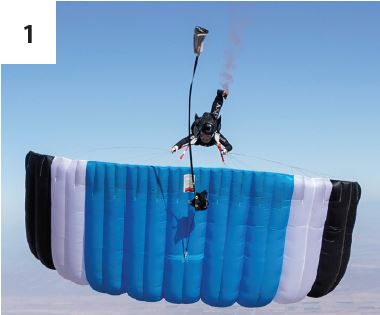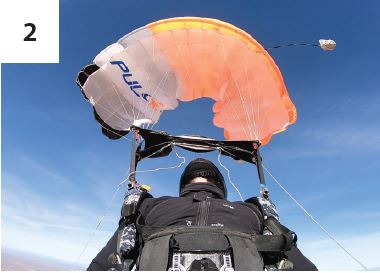Foundations of Flight | Canopy Turns, Spirals and Spins
 Brought to you by Niklas Daniel and Brianne Thompson of AXIS Flight School at Skydive Arizona in Eloy. Images by Niklas Daniel. For more skydiving educational content and professional coaching services, visit axisflightschool.com.
Brought to you by Niklas Daniel and Brianne Thompson of AXIS Flight School at Skydive Arizona in Eloy. Images by Niklas Daniel. For more skydiving educational content and professional coaching services, visit axisflightschool.com.
A canopy pilot will have better control and may respond with greater confidence in a situation involving a turn, a spiral or a spin (whether these maneuvers are practiced intentionally, experienced accidentally or brought on by a malfunction) if they can distinguish between and have a better understanding of them. It may be helpful to review the March and November 2022 installments of “Foundations of Flight” (available under the Back Issues tab at parachutist.com), which covered attitude and angle of attack.
Side note: The wing’s relationship to the relative wind, not the direction a pilot’s body is facing, determines a parachute’s flight path. For example, during a “blind-man” (canopy piloting freestyle maneuver), a canopy pilot intentionally turns their body 180 degrees in relation to the wing’s travel path by twisting the risers. Performed properly, this action does not affect the flight path of the wing.
Turns—Heading Changes
Turns are a combination of roll and yaw executed by manipulating the brakes, risers and/or harness. It is good practice to incorporate harness inputs through weight shift in addition to upper body inputs when turning a parachute. Just as a bicyclist leans into a turn while manipulating the handlebars, a coordinated turn under canopy offers a smooth experience. This is because the muscular effort of the arms reduces when weight shift is applied correctly, making the turn more effective. (The next installment of “Foundations of Flight” will address execution of harness turns.)
 Brianne Thompson in a spiral dive on a Performance Designs Sabre 3 107.
Brianne Thompson in a spiral dive on a Performance Designs Sabre 3 107.For skill-building purposes, the goal is to finish a turn on a desired heading without having to over-correct or without experiencing excessive pitch oscillations. (See April 2022 “Foundations of Flight.”) For most beginners, this requires stepping up the level of anticipation prior to a turn, reducing upper-body input and being patient in observing the canopy’s heading change to the desired flight path. Turning aggressively generally causes a heading overshoot that that the pilot needs to counter with opposite inputs. The pilot’s hands move up and down in an alternating fashion to recapture the desired heading. Avoid “milking the cow” and focus on exiting your turns smoothly, especially when turning onto final.
Spirals—Low Angle of Attack (descending quickly)
In a spiral, entered from a steep turn, the pilot then orients the nose of the wing towards earth. A rapidly descending roll-dominant turn with a nose-low attitude ensues. An increase in apparent weight (G forces) is felt in the legs pressing against the leg straps due to centripetal forces. In a spiral a canopy pilot maintains control with conventional inputs, though toggle and riser pressure may increase due to the increased airspeed. While spirals are a lot of fun to perform, a pilot’s situational awareness tends to diminish. While most skydivers should avoid performing spirals below their decision altitude, some high-performance canopy pilots use spiral dives to build speed before entering a competition course on the ground. During a malfunction where the canopy has entered a spiral with line twists, the pilot may be oriented back to earth, while the nose of the wings is pointing toward the ground. This is a spiral, not a spin; and should be dealt with urgently, as altitude and time are running out quickly.
Spins—High Angle of Attack (descending slowly)
 The left wingtip on this Performance Designs Pulse 190 is stalled while the right is still flying because the left brake line is pulled down more than the right.
The left wingtip on this Performance Designs Pulse 190 is stalled while the right is still flying because the left brake line is pulled down more than the right.A spin is a yaw-aggravated stall that results in rotation about the spin axis. For a spin to occur, the parachute must either be in a stalled configuration or experiencing a malfunction. In essence, half of the wing is stalled while the other is still flying, causing a rotation about the yaw axis. In photo 2, the left wingtip is stalled while the right is still flying. This is because the left brake line is pulled down more than the right. The wing drops in the direction of the stalled wingtip. This means the descent rate is slower than a spiral. Because of the aerodynamics at play, a canopy pilot must resort to unconventional inputs to recover from a spin (hands move up or in the negative direction). While counterintuitive, raising the hands slowly recovers the wing in a coordinated manner with the least amount of altitude lost. During a poor recovery where the hands travel up quickly, the parachute surges forward and can yaw faster than the pilot’s body and therefore cause line twists. Depending on the size and design of a parachute, a spin can be induced unintentionally with an aggressive toggle turn. This is especially dangerous near the ground.
In conclusion, having concise language and a reliable recollection of events is invaluable to the learning process. Spirals and spins require different sets of actions to recover from effectively. The main difference between the two is airspeed. Most skydiving parachutes are designed with such a degree of stability that if a maneuver is aborted, the system recovers on its own and returns to trim speed. However, the time it takes for a wing to recover naturally may be insufficient near the ground. Relying solely on a parachute’s design for stability and not actively participating is an attitude of resignation. Canopy pilots can learn how to avoid spins or spirals, and if necessary, skillfully manipulate their parachutes to force the recovery from spins or spirals in an effective manner.
Information about AXIS’ coaching and instructional services is available at axisflightschool.com. The authors intend this article to be an educational guideline. It is not a substitute for professional instruction.